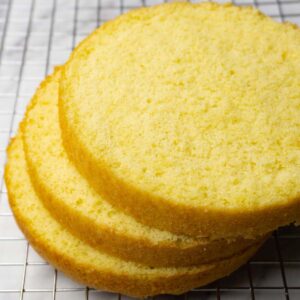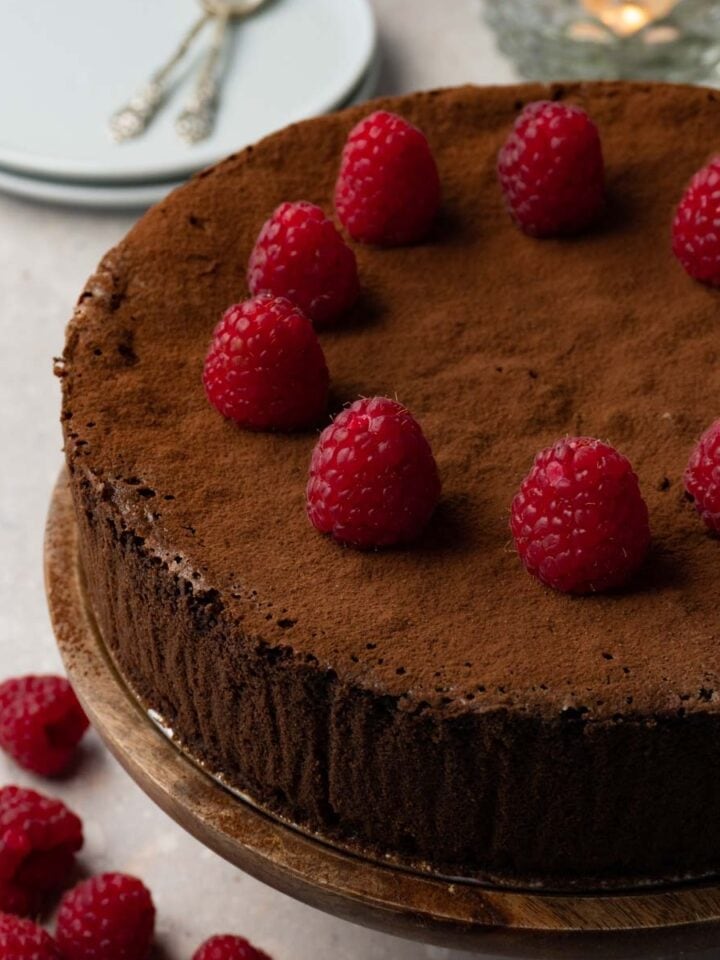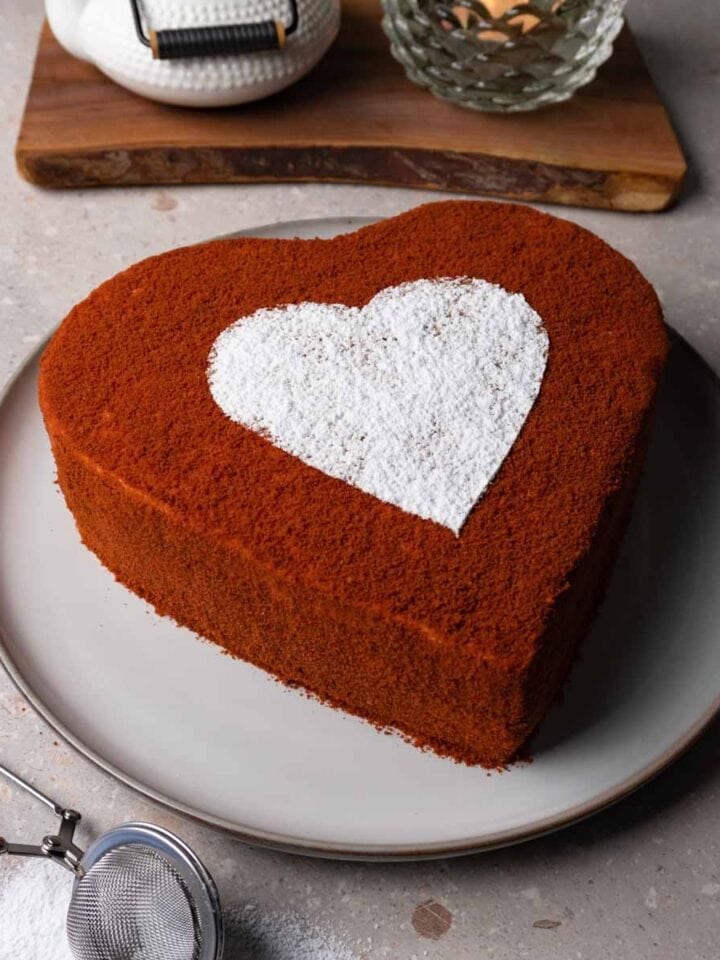The most basic sponge cake you can make to create a variety of cakes – the easy genoise sponge cake. It is made of a few ingredients and baked in just one cake pan, which cuts down your cooking time significantly.

Jump to:
Why you should have this recipe in your collection
The basic recipe can be changed to your taste. You can easily make a coffee or chocolate genoise knowing this basic vanilla recipe. It’s also possible to replace milk with orange juice or lemon juice and add zest to make this sponge fit your citrus cake.
Baked in one cakepan. Unlike American butter cake, this sponge can be baked in only one cake pan and then cut into layers, which cuts down your cooking time significantly. Of course, it should be a specific type of pan that is easy to buy online. And if you don’t want to buy it, it’s still possible to bake layers in several pans that you might already have at home. Also, you can bake this cake in a springform pan if it’s around 4” or 10cm tall.
Very light compared to a butter cake. The base of this cake is an egg foam, which means it’s significantly lighter (both in texture and in calories) than a butter cake.
Ingredients you will need
Flour – You can use either all-purpose flour or cake flour to make this genoise sponge recipe.
Salt – Never forget to add a pinch of salt when you bake anything.
Eggs – Eggs can be right out of the fridge since we’re going to heat them over a double-boiler anyway.
Sugar – I use white granulated sugar but you can be adventurous and experiment with coconut sugar, dark or light brown sugar, or make a mix out of several types of sugars.
Flavoring – For this basic sponge recipe. I use vanilla extract, but you can use other flavorings as well.
Fats – A classic genoise sponge includes melted butter only, but I think that this recipe – as well as other cake recipes – benefits from using unsalted melted butter as well as vegetable oil. Vegetable oil helps cakes stay softer and moister for longer. You can use canola, sunflower oil, or extra mild olive oil. The most important thing is that the oil of your choice should not have a strong flavor or smell.
Milk – Milk can be omitted completely or replaced with other things. If you make a lemon cake, you can replace it with lemon juice.

Cooking tips
Whip the eggs to the ribbon stage. This is a crucial part of this recipe. Under-whipped eggs will result in a very dense, low cake that will be impossible to slice into 3 layers, if that’s what you want to do with it. As you can see, we don’t use baking powder or baking soda here. The reason is that we rely on air bubbles to lift our cake during baking. Tons of air bubbles that were trapped in the whipped eggs and sugar mixture will expand under high temperatures and lift the cake, making it very soft and pillowy.
Fold the dry ingredients with a rubber spatula. After the flour is added, we need to work carefully to avoid deflating the egg mixture. For that, you should use a rubber spatula only. You need to fold the flour rather than mix it in.
Temper the milk and fats mixture. If we dump our fats and milk directly into the rest of the batter, they will sink to the bottom and it will be very difficult to combine them. So instead, we want to combine a little bit of batter with the fats and liquids to create an emulsion and only then add it to the main batter.
Leave the sides of a cake pan untouched. Don’t use any oil sprays, butter, or parchment paper on the sides of the pan. You want the cake to stick to it because this is how it climbs up, growing tall in the oven. You don’t have to worry about the release either – you will run the knife around the edge to release it flawlessly.
Bake right away. The genoise cake batter doesn’t like to wait on the counter because it can deflate. Bake it right away after you finished folding in the last ingredients.
Step by step directions
1. Preheat the oven to 340F or 170C and prepare a 6” by 4” (15cm by 10cm) round cake pan by covering the bottom with a piece of parchment paper. The sides of the pan should stay untouched!
2. In a heat-proof bowl, add the eggs, sugar, and vanilla extract. Place over a pot with slightly simmering water. Heat the mixture, stirring consistently, until warm to the touch and all sugar has dissolved. Remove from the heat.

3. Place the mixture in the bowl of a stand mixer fitter with a whisk attachment or use a hand mixer and whip for 7-10 minutes, or until the mixture becomes thick enough to leave a ribbon on the surface. When done, switch the mixer to medium-low and whip for one minute.
4. Sieve in the flour and salt and carefully fold with a rubber spatula until no dry ingredients are left.
5. In a small bowl add the oil, melted butter, and milk. Mix and add 2-3 tablespoons of the egg and flour mixture. Mix again until homogenous in consistency.
6. Add the milk mixture to the main batter and fold with the rubber spatula until fully incorporated.

7. Pour the batter into the prepared pan and bake for 35-40 mins or until the toothpick inserted in the center comes out clean and the surface of the cake bounces back if you gently press it.
8. Remove from the oven and let the cake cool down until you can safely touch the pan.
9. Run a knife against the wall of the pan to release the cake. Place on a cooling rack to cool down to room temperature. Wrap in plastic wrap and refrigerate for 4 hours or overnight. Serve with whipped cream and fresh berries or use to assemble a layer cake.
Why you should not divide this cake into layers while still warm
Warm genoise cake is a crumbly cake! The sponge needs some time to set and rehydrate. That’s why you want to cover it with plastic wrap after it cools down and refrigerate it for 4 hours. The moisture (which is in a hurry to leave the cake) will be captured and stay inside creating a very moist cake. If you don’t want to wait 4 hours, it’s best to bake your cake layers the day before you’re planning to assemble the cake.
If you’re in a hurry, however, you can slice a completely cooled sponge and use it. It will be a bit more crumbly, but nothing bad will happen.

How to make chocolate genoise
I love this recipe not because it’s so delicious but because it’s very versatile. You can make a chocolate genoise sponge by replacing some flour with cocoa powder.
For the chocolate cake, you’ll need 100g of all-purpose flour and 20g of cocoa powder. The rest of the ingredients stay the same! You will need to sift the cocoa powder with flour and salt into the egg and sugar mixture, then continue as described in the recipe card.
FAQ
You can make genoise 2-4 days before you’re planning to assemble the cake; store it tightly wrapped in plastic wrap in the fridge.
No. Once you finished preparing the cake batter, it should be poured into a cake pan and baked.
Yes, you can freeze it for up to 2 months.
Yes, it won’t hurt to use a little bit of simple syrup on each layer of the genoise sponge before frosting it.
More cake recipes
Recipe card

Genoise sponge
Equipment
- Digital kitchen scale
- Stand mixer or hand mixer and a large mixing bowl
- 1 6" (15cm) cake pan
Ingredients
- 4 large eggs at room temperature
- 120 g white granulated sugar
- 1 teaspoon vanilla extract
- 120 g all-purpose flour
- ½ teaspoon salt
- 35 ml milk at room temperature
- 20 g unsalted butter melted
- 20 g vegetable oil
Instructions
- Preheat the oven to 340F or 170C and prepare a 6” by 4” (15cm by 10cm) round cake pan by covering the bottom with a piece of parchment paper. The sides of the pan should stay untouched! No oil spray, no butter, no butter or flour, no parchment paper – nothing.
- In a heat-proof bowl, add the eggs, sugar, and vanilla extract. Place over a pot with slightly simmering water. Heat the mixture, stirring consistently, until warm to the touch and all sugar has dissolved. Remove from the heat.
- Place the mixture in the bowl of a stand mixer fitter with a whisk attachment (or use a hand mixer and a bowl) and start whipping, increasing the speed gradually for 7-10 minutes or until the mixture becomes very pale, has tripled in volume, and is thick enough to leave a ribbon on the surface. When done, switch the mixer to medium-low and whip for one minute.
- Sieve in the flour and salt and carefully fold with a rubber spatula until no dry ingredients are left.
- In a small bowl add the oil, melted butter, and milk. Mix and add 2-3 tablespoons of the egg and flour mixture. Mix again until homogenous in consistency.
- Add the milk mixture to the main batter and fold with the rubber spatula until fully incorporated.
- Pour the batter into the prepared pan and bake for 35-40 mins or until the toothpick inserted in the center comes out clean and the surface of the cake bounces back if you gently press it.
- Remove from the oven and let the cake cool down until you can safely touch the pan.
- Run a knife against the wall of the pan to release the cake. Place on a cooling rack to cool down to room temperature. Wrap in plastic wrap and refrigerate for 4 hours or overnight.
- Then, slice into 3 even cake layers and assemble the cake – or cover the unsliced sponge with plastic wrap and refrigerate for up to 4 days. Alternatively, cut and serve with powdered sugar, fresh berries, jam, or any other sauce you like.





Leave a comment